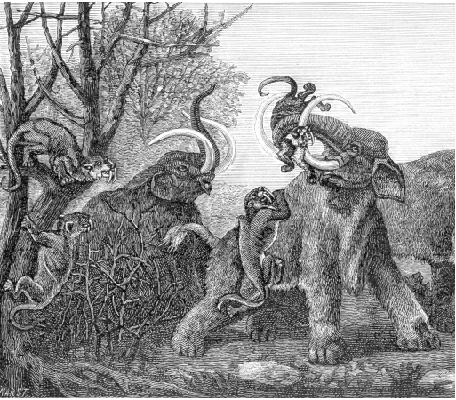Era of mammals
Table of Contents
Cenozoic Era is the last geologic period and is often referred as the age of mammals. It is thought to begin 65 million years ago and continued till present. The name Cenozoic means new life. With the destruction and perish of dinosaurs by the end of the Cretaceous period, this era has set the stage for the rising and abundance of mammals, modern birds, insects, flowering plants, reptiles, newest fishes, trees, grasses and various other forms of life. Thus there is a birth of new life all across the world. However, this period is mainly dominated by various species of mammals and the new life, is particularly, can be termed for the mammals. Most of the groups like reptiles, birds, fishes and other life forms have evolved into the modern or current era of today’s world.

Cenozoic Era and Mammals
As said above there was a significant development in different species of mammals. In fact, mammals have gone through great evolution in this period. The insignificant stature of Mammals came distinct through evolution in this period from the Meesozoic era, the age before Cenozoic Era.
Evidence of gigantic mammal species proved the dominance of varieties of mammals in this period, many of which suffered from extinction and are counted in extinct species of mammals in today’s geology. However, it is a question till now that whether the gigantic mammals had reached the size of dinosaurs or not but it has also been proved that some of the Cenozoic mammals are the predecessors of today’s dwarfed species. Really, great are the natures of evolution!
Study of life forms and Division of the Cenozoic era
Division of the Cenozoic era will help to study life forms of the period prominently. This era is divided into 3 periods like the Paleogene period, the Neogene period, and the Quaternary period. Each of these periods is consisted of several epochss. The Paleogene period is sub divided into Palaeocene epoch, Eocene epoch, and Oligocene epoch. The Neogene is divided into the Miocene and the Pliocene epoch. The Quaternary period is sub divided into the Pleistocene epoch and the Holocene epoch. Each of these epochs has contributed to the growth of different species of life forms including the mammals.
Mammals of the Palaeogene period
Mammals like dogs, rhinoceroses, cats, peccaries, and pigs gained prominence in this period. Horses too flourished in the North America. Lands of the North America and Asia are occupied with Gigantic Brontotheres, giant pigs like Archaeotherium. Camels also began to dominate the land and armadillos and ground sloths too appeared. Among the small mammals Rodents gained prominence. Hyracotherium, a species of small horses were also common. Early elephants and rhinoceroses too appeared along with the massive Uintatherium.
Mammals of the Neogene period
This is the period of Bovids like cattle, goats, sheep, gazelle, and antelope. Elephants, camels, horses, peccaries, rhinoceroses, and tapirs were also common. Rodents like beavers and ground-squirrels were in abundance. Deinotherium was in rise with sloth Megatherium and long-necked Macrauchenia. The latter belonged to the extinct mammals called Litopterns. Stoats, weasels, dogs, and sabre-toothed cats were the mammals of this period. This was also the time when Primates appeared with the early man.
Mammals of the Quaternary period
Mammals of this period include species of woolly rhinoceroses, Sabre-toothed cats, woolly mammoths, giant deer, cave lions, and cave bears. However, most of these are now counted in extinct species of mammals.
Gigantic birds of the Cenozoic Era
Have you heard of mammoths? Sure you have. But do you know that in the Cenozoic period there were birds which were as long as 7 ft. Fossils of beavers proved that these species were 7 ft long. Growth achieved by these species is due to the development typical of this ‘new life’ period. Hawks, geese, owls, herons and ducks were also prominent in the era.
Cenozoic Era: Flowering plants
Cenozoic is also the era of flowering plants. Angiosperms or flowering plants are widely spread in this era. One of the interesting facts of these flowering plants is that these plants have symbiotic relationships with many insects and they are really beneficial to the latter. Insects also became necessary to pollinate the flowering plants.
Cenozoic Era Species in Sea
Dugongs and sea whales were abundant. Giant sharks, echinoids, gastropods, and corals too dominated the seas. Bivalves, hexacorals, fishes, crabs, and whales too appeared in this era.
Moving of continents in the Cenozoic Era
Separations of continents were prominent in the Cenozoic Era. Widening of the Atlantic rift forced in continental separations like the Europe and Germany. Separations between Africa and India and Australia and Antarctica were caused due to rifts of spreading ocean.
Rise of mountains due to volcanic activities
Formation of mountain ranges took place due to the rifts occurred throughout the globe for volcanic activities. One of the prominent examples of mountain formation is the Cascade Range. Volcanic activities in the continents like Asia, Europe, and Africa caused the formation of mountain systems of the Alpine and the Himalaya.
Thus it can be said that the Cenozoic Era is truly the era of life forms. From mammals to birds, reptiles, insects, plants and other life forms all find their scopes to rise in dominance in the era. While some of the species of this era had turned into extinct many others have taken new forms through evolution to reach the modern age. In fact, we the modern man have our evolution started from this Cenozoic Era.
